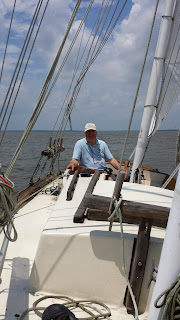Not knowing a lot about diesel behavior, the whole notion of pulling Mr Vetus out of the boat, hauling it up the road, diagnosing it and deciding on a course of action, was almost overwhelming.
Schooner Jacob Jones, being a small schooner 31 feet overall (and quite a sizable portion of that is bowsprit), has a very small Vetus diesel engine. It's a mid-to-late 1980's Vetus, an M2.05, which is a very rare engine indeed. It would be impossible to fix or maintain over the longer haul if it didn't share a key characteristic with a much more popular engine of some repute. You see, a Vetus M2.05 is based on a Mitsubishi core, a K2AS, which was also used, thankfully for this exercise, within the Westerbeke 10 Two. Yep, the parts I generally needed were common to the 10-Two.
The K2AS is a interesting engine. It was quite the feat of small, light diesel engineering -
this SAE paper describes the engine's basics. It was apparently used in a variety of generators, marine diesels, and a few small tractors. So that's pretty cool.
But then Vetus managed to embed this OEM core inside of one of the initial range offerings that gradually ended up producing the entire series of smaller Vetus diesels, all of which are wildly more popular than this little M2.05. The M2.06 for instance, which I would give my eye teeth to replace the M2.05 with, has many more instances. (or a lust, lust, Beta for that matter).
But putting thousands into this little boat to re-power her was not in the cards. So, let's pull it out and poke around it's innards and see why it had been misbehaving....
In the late summer of 2011, trying to get ready for a long trip, I had her out and doing "speed trials" (which is a misnomer for the eventual 4.2 knots we got from her at WOT). But she was throwing a lot of soot out the tailpipe. The engine was laboring, overloaded and all the easy diagnosing pointed to Mr Vetus being beyond repair. The fuel, the oil, the air intake, the compression (which was low-ish in number 1 and really low in number 2), the fuel injectors, and a few other items all checked out. The head remained. Were the valves all crudded up or was the problem even more evil, something wrong with the governor or god-knows-what?
In the fall of 2011, I had managed to get the boat ready to move across the Bay from Worton's to Baltimore to try to reach the start of the Great Chesapeake Bay Schooner Race. The morning of the attempt, we had trouble getting her into gear, she'd die. We started her in gear, she'd die. Just nothing. Disappointment.
We tried to perform extraordinary measures. Nothing. Giving up on the attempt, we still went over to the GCBSR in Baltimore's Inner Harbor, and got to take a ride on the Norfolk Rebel. It was both cold and windy, but at least it was raining! Very nice modern yachting session. Some of the big schooners were literally "romping" and it was a sight to see.
A few weeks later - we pulled the motor out of the hull. The Professor just kept undoing bolts until Mr Vetus came loose. Loaded her on a trailer using the Marina's "stabbing crane" and brought her home.
As we took it all apart, it became quite clear the problem was with the valves in the cylinder head. Soot, corrosion and pits! We separated the head from the block took it down to a speed shop here in Wilmington (Accurate Machine of Newport) where Jim took one looks and said - "there's your problem". The second cylinder's exhaust valve was not doing it's job nearly well enough. At this point, it's suspected that when the boat sat over several years on a trailer, the second cylinder's exhaust valve was open to the world, rust, moisture, and badness settled in like pneumonia in an old man.
When we began running the motor 5 or 6 years back, lots of trouble. And no end of it, just gradually getting worse.
So hope springs eternal now, the head is back, all the valves replaced, one of the seats replaced, and the motor ready for re-assembly. Then put it back in and and....
Well, yes, we'll see...




